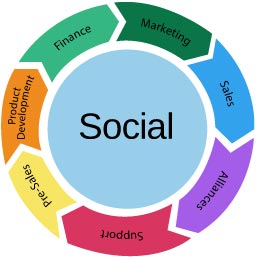The number one failure of social marketing implementation lies in the silos of the organization. “Social” is actually not a marketing function but instead an entire organization’s role. Unless it is carefully orchestrated through all segments of the business and endorsed by leadership, it will not succeed.
Social should be integrated throughout the organization and each department should have at least one person holding “community” in his/her title. Here is how each department can contribute to a Social Business Strategy.

MARKETING
- Driving the Listening, Learning, Adapting
- Search Analysis
- Metrics
SALES
- What questions do customers ask?
- Who are customers listening to?
- What seems to be their #1 concern?
ALLIANCES
- What are the partners saying about the product?
- Is doing business with us easy or challenging?
- Where do they see potential growth or failure?
SUPPORT
- Why are products being returned?
- What are the top queries from customers?
- What seem to be broken?
PRE-SALES
- What are the customer pain-points?
- What motivates the customer to inquire about product/solution?
- Who else are they evaluating?
- Where do they gather information?
PRODUCT DEVELOPMENT
- What is the process to integrate customer feedback into new releases?
- Who is responsible for gathering customer input and how is it done?
FINANCE
- How much does it cost the company to handle returns?
- What is the actual budget to operate the customer service organization?
- How many deals did we lose to competition and why?
- Where are we earning net-new dollars?
The ultimate goal of social practices is to engage the customers and achieve collaborative marketing. Yet, the Operations department in an organization often drives the conversations much more than marketing does. The way the business is managed becomes the focus of the effort rather than brand messaging. Operations become a key piece of the puzzle.
Some benefits of integrating Social interaction in the entire organization:
- The business gets a competitive edge by being able to adapt faster to changes and requests from customers.
- The customer feedback drives product innovation and speeds-up delivery
- Customer service expenses decrease when the Community helps other solve their problems
- Sales promotions are timed accurately and respond to customers appeal
- Customers act as your ears and eyes in the industry and report on trends and changes
The new generation: the Connected Customer can only be serviced by a connected organization.
Therefore, it is time to break the silos and establish a company-wide social initiative and harvest these benefits.

